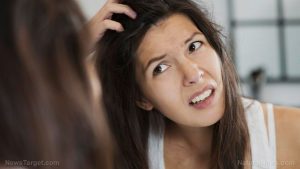
Pediculosis capitis – causes, side effects and treatments at NaturalPedia.com
Wednesday, May 30, 2018 by Janine Acero
http://www.naturalpedia.com/pediculosis-capitis-causes-side-effects-and-treatments-at-naturalpedia-com.html

Pediculosis capitis refers to the infestation of the hair and scalp by human head lice (Pediculus humanus capitis). This common condition occurs worldwide and in individuals of all socioeconomic backgrounds.
In the U.S., pediculosis capitis is most common among preschool- and elementary school-age children and their caretakers/household members.
Head lice are not known to transmit disease, but it can lead to secondary bacterial infection of the skin from constant scratching of the scalp.
The most common way to get head lice is by close contact with an infested person, such as children playing together at school, home, or elsewhere (playground, camp, slumber parties).
Uncommon transmissions include:
- Contact with clothing items (hats, scarves, coats, sports uniforms, or hair ribbons) worn by an infested person;
- Using infested combs, brushes or towels; or
- Lying on a pillow, bed, or stuffed animal that has recently been in contact with an infested person.

Known symptoms, risk factors for pediculosis capitis
Several telltale signs that the bugs are present on the scalp include:
- A ticklish feeling on the scalp or neck.
- An itchy scalp.
- Small red bumps on the scalp (sometimes on the neck and shoulders too)
- The presence of nits (lice eggs) on the hair.
- Irritability and difficulty sleeping.
Some people may scratch their scalps raw due to the itch and cause sores and other skin infections.
Developing pediculosis is more likely with the following risk factors:
- Being in overcrowded places
- Poor standards of hygiene
- Those who live on the streets and unsanitary places
- People moving from one place to another and not settling down in one place (such as refugees)
- Girls/women are at high risk for head lice
- The infection is more common during the summer, warmer months
Body systems harmed by pediculosis capitis
Lice are parasitic insects that feed on human blood, living on the clothing and bedding of infected humans, causing severe itching.
There are three types of lice that reside and feed on blood at different locations of the human body:
- Pediculus capitis or head lice that live in the hair on the head.
- Pediculus corporis or body lice found along the seams of infrequently changed and washed clothing.
- Pediculus pubis which are pubic lice (body crab) found in the pubic hair, but may also occur in the facial hair such as the eye lashes and eye brows, chests, armpits, and abdomen.
Food items or nutrients that may prevent pediculosis capitis
There are no certain food or nutrients that may prevent head lice infestation, but there are herbal remedies, mostly essential oils, with insecticidal properties have been used to get rid of head lice and relieve the itching. These include:
- Citronella Grass essential oil
- Quassia bark extract
- Balsam of Peru liquid resin extract
- Sugar apple (Annona squamosa) leaves
- Tea tree oil
- Lavender oil
- Neem oil
- Rosemary
- Soap plant
One effective oil combination is 20 drops tea tree oil, 10 drops rosemary oil, and 15 drops each of lemon oil and lavender oil. Mix all this into four tablespoons vegetable oil. Rub the mixture into your dry hair, cover your head with a plastic shower cap, then wrap that with a towel. After an hour, unwrap your head, shampoo well, and rinse.
Treatments, management plans for pediculosis capitis
One effective treatment for head lice infestation is using a delousing shampoo. Leave it in your hair for 10 minutes. After you rinse out the shampoo, rinse it again using 50 percent water and 50 percent white kitchen vinegar. Use the louse-killing shampoo again 10 days later.
If you’re still not getting results, mix a half-cup vinegar with a half-cup olive oil. Apply this mixture to your hair, working it in close to the scalp. Put a shower cap over your hair.and leave it for about one hour before you shower. Remove the cap and take your shower, washing your hair with regular shampoo.
Where to learn more
- How to Prevent and Treat Head Lice Naturally
- Insecticidal resistance in head lice leads to search for natural treatment
- Poisoned: Toxic head lice treatment linked to alterations in behavior
- Most head lice now resistant to common insecticides, new study finds
- School head lice policies require a new look at old standards
Summary
Pediculosis capitis is the infestation of the hair and scalp by human head lice (Pediculus humanus capitis).
In the U.S., it most commonly occurs among preschool- and elementary school-age children and their caretakers/household members. Head lice don’t transmit any diseases but an infestation will cause itchy scalp that could lead to skin infections.
Sources include:
Tagged Under: Tags: Pediculosis capitis





